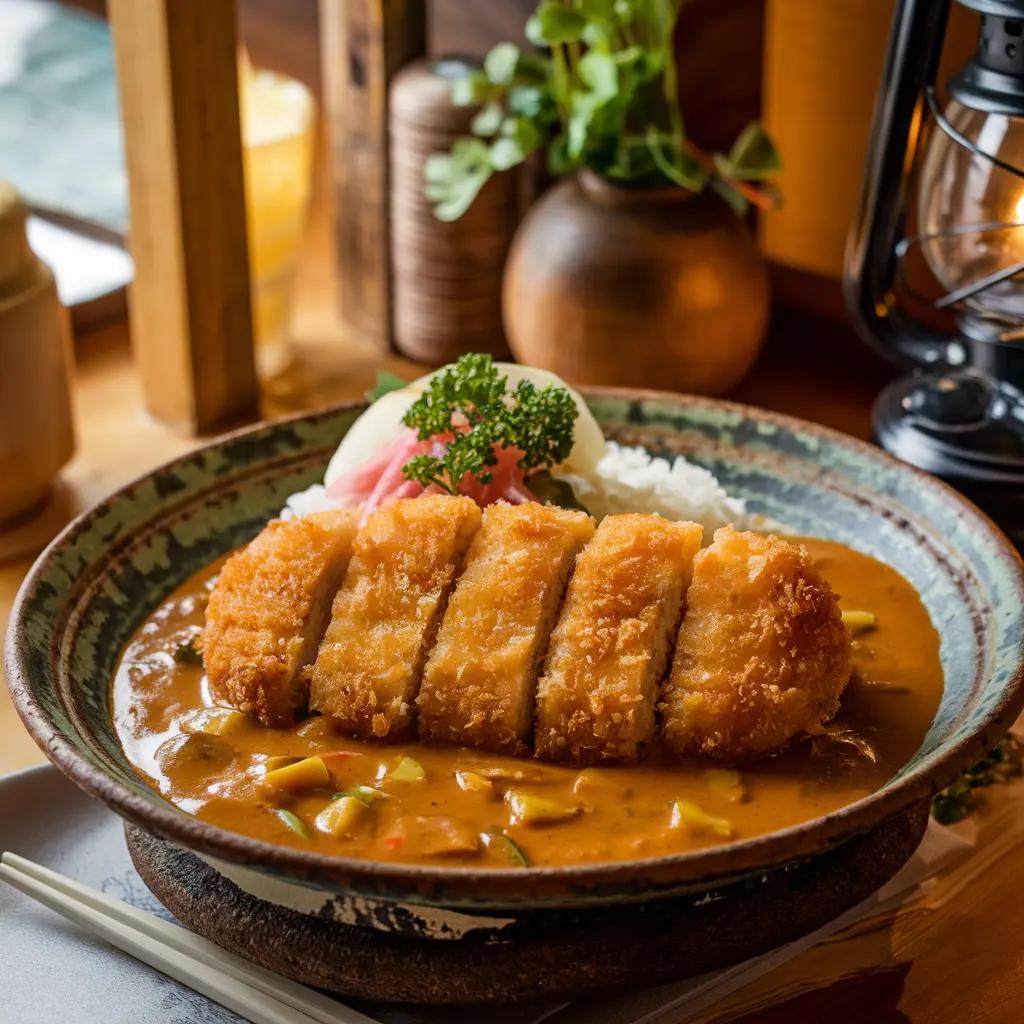Katsu Curry is a popular Japanese dish that combines crispy breaded meat, usually pork or chicken, with a flavorful curry sauce served over steamed rice. This comfort food is loved worldwide for its unique blend of textures and savory flavors. The word “katsu” comes from “katsuretsu,” meaning cutlet, while “curry” refers to the spiced sauce introduced to Japan from Britain through India.
Table of contents
Definition and Origins
Consists of two main components: a fried, breaded meat cutlet and a rich, slightly sweet curry sauce. Traditionally, the meat is coated in panko breadcrumbs and deep-fried until golden brown. The dish is served with a thick, mildly spiced curry sauce poured over the cutlet and a side of steamed white rice. Pickled vegetables like fukujinzuke or rakkyo often accompany the meal, adding a tangy contrast.
Cultural Significance in Japan
In Japan, is more than just a meal—it’s a beloved part of the culinary culture. It is frequently found on menus in restaurants, school cafeterias, and even convenience stores. The dish is associated with comfort and home cooking, making it a go-to meal for many Japanese families. It’s also popular among students and professionals for its satisfying and energizing qualities.
Ingredients of Katsu Curry
The magic of Katsu Curry lies in its perfectly balanced ingredients, which create a satisfying combination of textures and flavors. From the crispy breaded cutlet to the rich curry sauce and fragrant rice, each element plays a crucial role in this iconic dish.
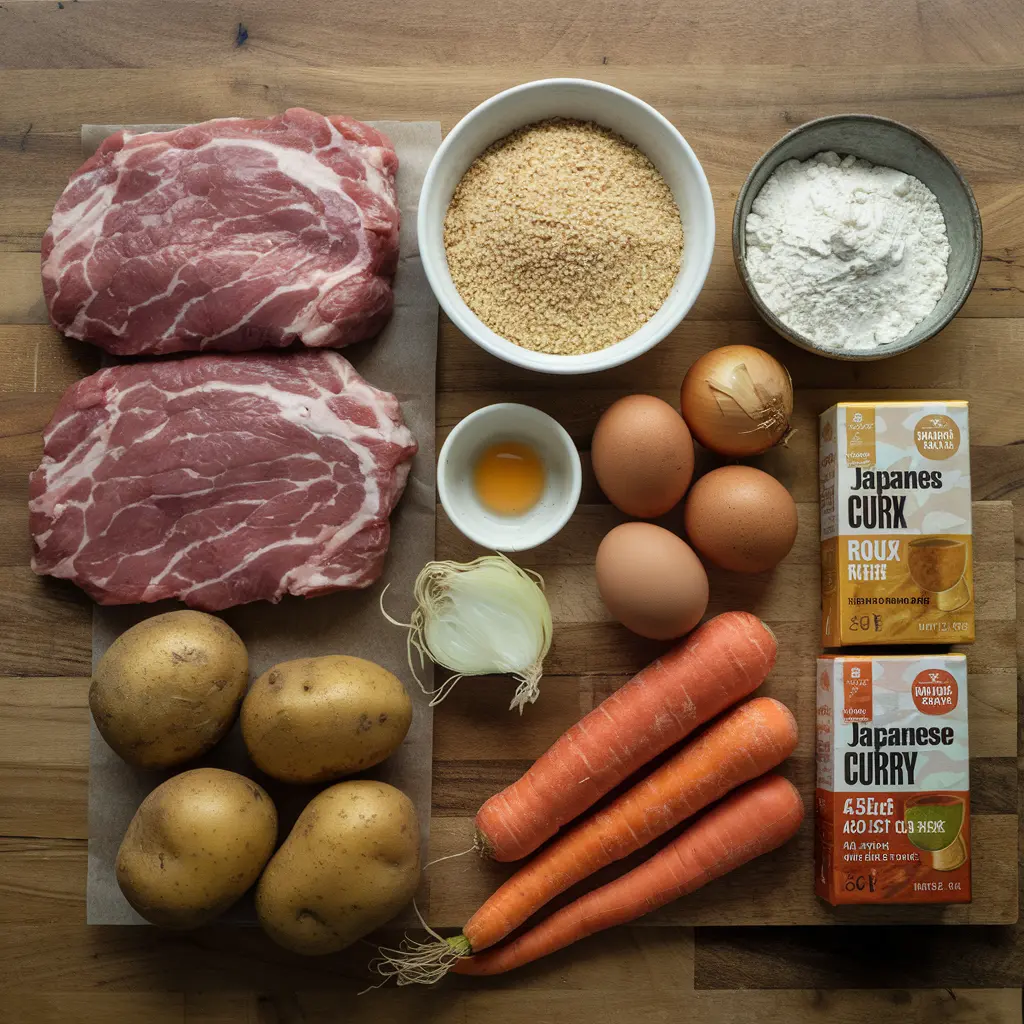
Core Ingredients
- Meat (Protein):
- Chicken: Chicken breast or thigh is a popular alternative, especially for a lighter version.
- Tofu or Vegetables: For vegetarian and vegan options, firm tofu or root vegetables like sweet potatoes can replace meat.
- Curry Sauce Base:
- Curry Roux Blocks: Pre-made Japanese curry roux blocks are widely used for convenience.
- Vegetables: Common vegetables include onions, carrots, and potatoes for sweetness and thickness.
- Broth or Water: Used to simmer the sauce and dissolve the roux.
- Seasonings: Soy sauce, Worcestershire sauce, and grated apples or honey add depth and sweetness.
- Rice:
- Short-grain White Rice: Japanese short-grain rice is the standard, offering a sticky texture that pairs well with the sauce.
- Breading Ingredients for Katsu:
- Flour: For the first coating layer.
- Eggs: Beaten eggs help the breadcrumbs stick.
- Panko Breadcrumbs: Light and flaky Japanese-style breadcrumbs create the signature crispy coating.
- Oil for Frying:
- Neutral Oil: Such as vegetable or canola oil, for deep frying the cutlet.
- Pickles (Optional):
- Fukujinzuke: Sweet and tangy pickled vegetables.
- Rakkyo: Pickled shallots add a mild sharpness.
Variations by Region
- Kansai Region: Known for thicker, richer curry sauces with a darker, more robust flavor.
- Kanto Region: Prefers lighter, sweeter curry with a smoother texture.
- Hokkaido Style: Often includes local seafood and cream for a unique twist.
- International Variations: Global interpretations include adding cheese, spicy sauces, or even serving the dish with naan bread in fusion-style restaurants.
How to Make Katsu Curry at Home
Making Katsu-Curry recipce at home is both rewarding and straightforward. With the right ingredients and a bit of preparation, you can recreate this Japanese comfort dish in your own kitchen. Here’s a detailed step-by-step guide to making authentic Katsu Curry.
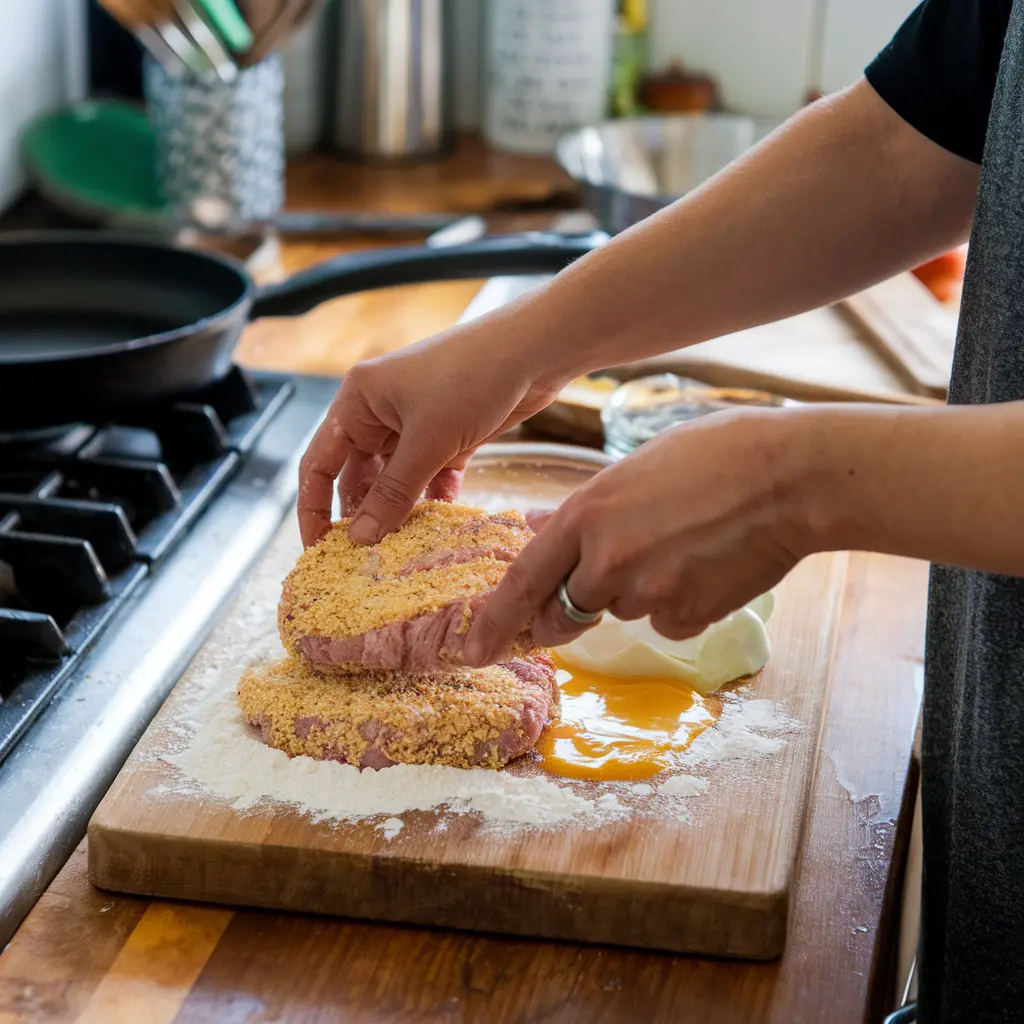
Step-by-Step Preparation
1. Preparing the Rice
- Ingredients: Short-grain white rice (1 1/2 cups) and water (2 cups).
- Instructions:
- Rinse the rice under cold water until the water runs clear.
- Add the rinsed rice and water to a rice cooker or saucepan.
- Cook according to the manufacturer’s instructions or simmer on low heat until tender.
2. Making the Curry Sauce
- Ingredients:
- 2 large onions (thinly sliced)
- 2 carrots (diced)
- 2 potatoes (cubed)
- 4 cups of water or broth
- 1 pack of Japanese curry roux (mild, medium, or hot)
- 1 tbsp soy sauce (optional)
- 1 tbsp Worcestershire sauce (optional)
- Instructions:
- Heat oil in a large saucepan over medium heat. Sauté the onions until caramelized.
- Add the carrots and potatoes, cooking for 5 minutes.
- Pour in water or broth and bring to a boil.
- Lower the heat and simmer for 20 minutes until the vegetables are tender.
- Break the curry roux blocks into the saucepan and stir until dissolved.
- Simmer for another 10 minutes, stirring occasionally. Add soy sauce or Worcestershire sauce for extra flavor.
3. Preparing the Katsu (Breaded Cutlet)
- Ingredients:
- 4 boneless pork or chicken cutlets (about 1/2 inch thick)
- Salt and pepper (to taste)
- 1/2 cup all-purpose flour
- 2 large eggs (beaten)
- 1 cup panko breadcrumbs
- Oil for frying
- Instructions:
- Season the cutlets with salt and pepper on both sides.
- Dredge each cutlet in flour, shaking off the excess.
- Dip into the beaten eggs, ensuring full coverage.
- Coat thoroughly with panko breadcrumbs, pressing gently to adhere.
- Heat oil in a deep frying pan or skillet to 350°F (175°C).
- Fry the cutlets for 4-5 minutes per side until golden brown and fully cooked.
- Transfer to a wire rack or paper towel-lined plate to drain excess oil.
4. Assembling the Dish
- Place a generous portion of steamed rice on one side of the plate.
- Slice the katsu into strips and arrange it next to the rice.
- Ladle the hot curry sauce over the katsu or serve it on the side.
- Garnish with fukujinzuke (pickled vegetables) or freshly chopped parsley.
Essential Cooking Tips
- Use Fresh Ingredients: Fresh vegetables and high-quality meat ensure the best flavor.
- Double Fry for Extra Crispiness: Fry the katsu a second time briefly for an ultra-crispy crust.
- Adjust Spice Level: Customize the curry’s heat by mixing mild and hot curry roux blocks.
- Vegetarian Tip: Substitute tofu or eggplant for the cutlet and use vegetable broth for the curry sauce.
Nutritional Information of Katsu Curry
Katsu Curry is a flavorful and filling dish, but its nutritional profile can vary depending on portion size, ingredients, and preparation methods. Understanding its nutritional breakdown helps you make informed choices while enjoying this iconic Japanese comfort food.
Caloric Content
The caloric value of Katsu Curry depends on factors like meat type, frying method, and sauce thickness. Here’s a typical nutritional breakdown for a standard serving (one plate) containing pork katsu, curry sauce, and rice:
- Calories: 800-1,200 kcal
- Protein: 30-40 grams (from meat or plant-based alternatives)
- Carbohydrates: 90-110 grams (mainly from rice and curry sauce)
- Fats: 35-50 grams (from frying oil and breading)
- Fiber: 5-8 grams (from vegetables in the curry)
Note: Vegan and vegetarian versions typically have fewer calories and fat due to the lack of meat and reduced oil use.
Health Benefits and Considerations
Despite being a calorie-dense dish, Katsu Curry offers several nutritional benefits when prepared mindfully. Let’s explore its pros and considerations:
Health Benefits:
- High in Protein:
- Meat-based versions provide essential protein for muscle maintenance and tissue repair.
- Plant-based options using tofu or seitan also offer a good protein source.
- Rich in Vitamins and Minerals:
- Potatoes, carrots, and onions in the curry provide vitamins A, C, and B6, as well as potassium and dietary fiber.
- Energy Boosting:
- The carbohydrate content from rice ensures long-lasting energy, making Katsu Curry an ideal meal for active individuals.
- Antioxidant Properties:
- Spices like turmeric and ginger in the curry roux may have anti-inflammatory and antioxidant effects.
Health Considerations:
- High in Calories and Fats:
- The deep-fried cutlet contributes significant fat and calorie content. Consider baking or air-frying the katsu for a healthier version.
- High Sodium Content:
- Pre-made curry roux blocks can be high in sodium. Opt for reduced-sodium brands or make your curry from scratch to control salt levels.
- Refined Carbohydrates:
- White rice is a high-carb ingredient. Replacing it with brown rice or quinoa can improve the dish’s nutritional balance.
- Allergens:
- Gluten (from panko and roux) and dairy (from some curry sauces) may cause issues for individuals with specific dietary restrictions. Look for gluten-free or dairy-free alternatives if needed.
How to Make Katsu Curry Healthier
- Choose Lean Protein:
- Use chicken breast, turkey, or plant-based proteins to reduce fat content.
- Bake or Air-Fry the Cutlet:
- Skip deep frying and bake the cutlet in the oven or air fryer for similar crispiness with less oil.
- Reduce Curry Sauce Calories:
- Use homemade curry sauce with fresh vegetables and reduce added sugars and fats.
- Add More Vegetables:
- Include extra vegetables like bell peppers, spinach, or broccoli for added nutrients and fiber.
- Watch Portion Sizes:
- Serve smaller portions of rice and increase the vegetable content for a more balanced plate.
Popular Katsu Curry Brands and Restaurants
Katsu Curry has gained international popularity, leading to the rise of numerous brands and restaurants specializing in this beloved dish. From authentic Japanese chains to global franchises, these eateries have played a significant role in making Katsu Curry a household name worldwide.
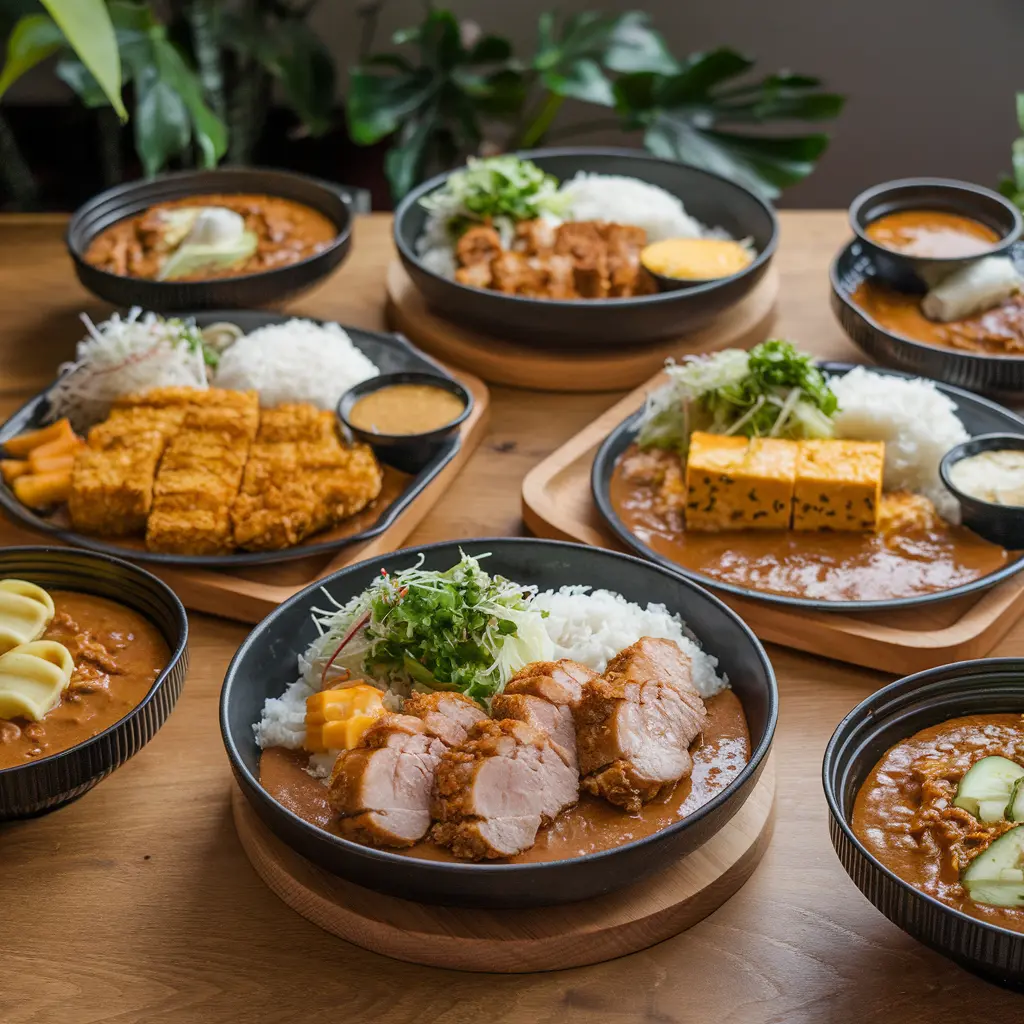
Famous Japanese Katsu Curry Chains
- Coco Ichibanya
- Overview: Coco Ichibanya is Japan’s most famous curry house chain, known for its customizable Katsu Curry options. Diners can choose spice levels, portion sizes, and toppings, making it a favorite among locals and tourists.
- Signature Dish: Pork Katsu Curry with cheese and a soft-boiled egg.
- Tonkatsu Wako
- Overview: While more focused on Tonkatsu (breaded pork cutlet), Tonkatsu Wako serves an excellent version of Katsu Curry. Its expertly fried cutlets and rich, flavorful curry sauce set a high standard.
- Signature Dish: Pork Loin Katsu Curry with miso soup and side salads.
- Matsuya
- Overview: A popular Japanese fast-food chain, Matsuya is famous for its affordable Katsu Curry meals. It’s perfect for those seeking a quick, filling meal on a budget.
- Signature Dish: Beef Katsu Curry with extra curry sauce.
- Go! Go! Curry!
- Overview: This energetic chain is famous for its hearty portions and unique curry presentation. The restaurant’s name reflects Japan’s love for curry and plays on the Japanese word for “5” (go).
- Signature Dish: The Grand Slam Curry, featuring multiple katsu types and extra toppings.
International Katsu Curry Restaurants
- Wagamama (UK, US, Global)
- Overview: Wagamama offers an internationally inspired take on Katsu Curry with a modern twist. Its globally influenced menu includes vegetarian and vegan-friendly Katsu Curry options.
- Signature Dish: Chicken Katsu Curry with sticky rice and side salad.
- Fuji Japanese Restaurant (US)
- Overview: This well-regarded chain in the U.S. serves authentic Japanese dishes, including classic Katsu Curry.
- Signature Dish: Pork Katsu Curry with pickled vegetables.
- Ichiban Sushi (Asia, Australia, Europe)
- Overview: Known for its broad Japanese menu, Ichiban Sushi includes Katsu Curry in its offerings, making it a hit with international diners.
- Signature Dish: Chicken Katsu Curry Bento Box.
Why These Brands Stand Out
- Authentic Flavor: Many of these chains maintain authentic Japanese recipes while catering to global tastes.
- Customizable Options: Restaurants like Coco Ichibanya and Go! Go! Curry allow customization, from spice levels to extra toppings.
- Global Reach: With franchises in countries such as the US, UK, and Australia, these brands have made Katsu Curry accessible worldwide.
- Consistency and Quality: Chains ensure standardized cooking processes, guaranteeing familiar tastes at different locations.
How to Serve and Enjoy Katsu Curry
Is more than just a meal—it’s a culinary experience. The way it is served and paired with complementary sides enhances its flavor and creates a satisfying dining experience. Here’s how to serve Katsu Curry like a pro and enjoy it to the fullest.
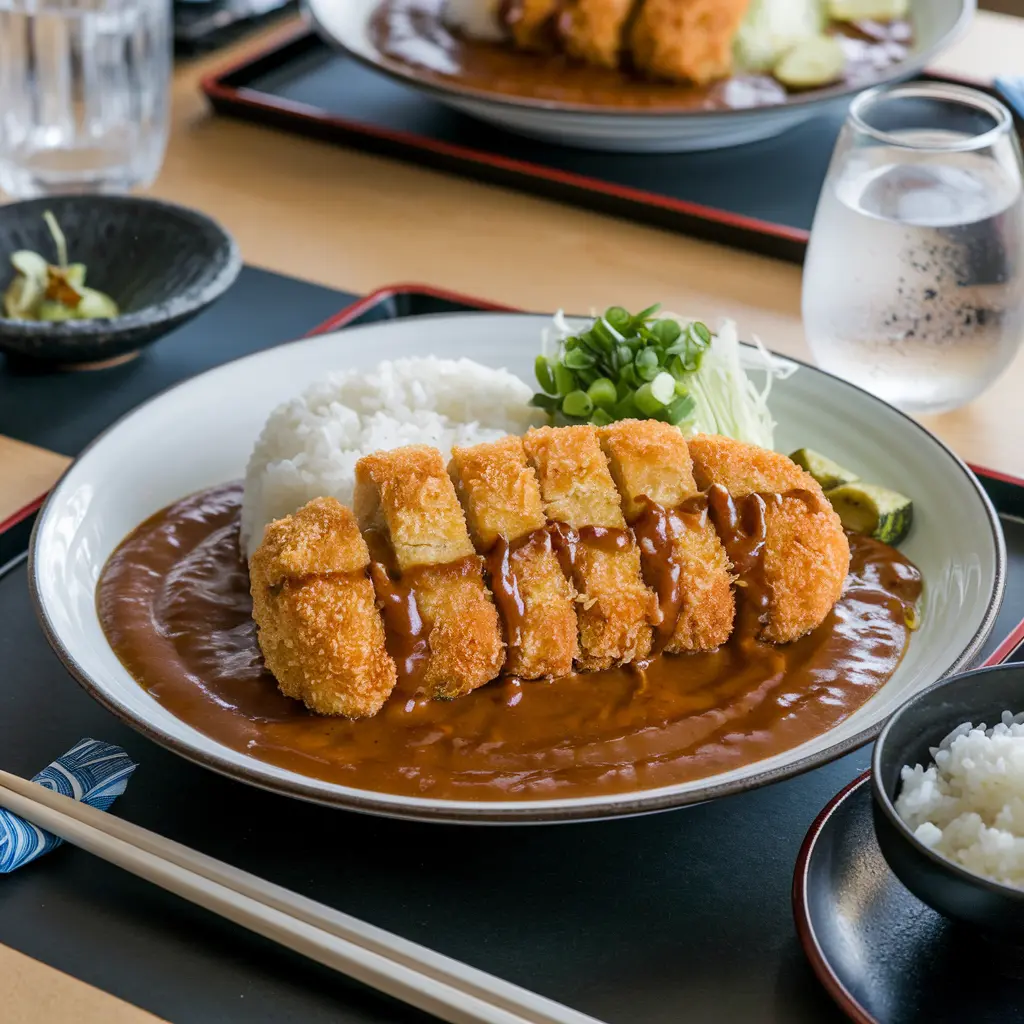
Best Way to Serve Katsu Curry
- Plating the Dish:
- Use a large, shallow plate or bowl to accommodate the components neatly.
- Place a generous mound of steamed rice on one side of the plate.
- Slice the katsu cutlet into strips for easy eating and arrange it next to the rice.
- Ladle the hot curry sauce over the cutlet or pour it on the side for dipping.
- Garnishing Tips:
- Sprinkle chopped parsley or green onions for added freshness.
- Add a drizzle of tonkatsu sauce for extra richness.
- Serve with a lemon wedge for a citrusy kick.
Recommended Side Dishes and Beverages
Pairing Katsu Curry with the right sides and drinks enhances its taste and makes for a balanced meal. Here are popular accompaniments:
Side Dishes:
- Pickled Vegetables (Fukujinzuke & Rakkyo):
- These sweet and tangy pickles balance the richness of the curry sauce.
- Miso Soup:
- A light, savory miso soup helps cleanse the palate between bites.
- Green Salad with Sesame Dressing:
- A fresh, crunchy salad adds a refreshing contrast to the warm curry.
- Gyoza (Japanese Dumplings):
- Crispy or steamed gyoza makes an excellent appetizer.
- Edamame:
- Lightly salted boiled soybeans are a healthy and tasty snack.
Beverages:
- Green Tea (Hot or Iced):
- Helps cut through the dish’s richness while promoting digestion.
- Beer (Japanese Brands):
- Light, crisp beers like Asahi, Sapporo, or Kirin pair perfectly with the savory flavors.
- Sake (Cold or Warm):
- A light, dry sake complements the spices in the curry sauce.
- Soft Drinks or Sparkling Water:
- These provide a refreshing contrast to the heavy meal.
Traditional Presentation in Japan
- Bento-Style Serving:
- Katsu Curry is often packed in bento boxes for convenient takeaway meals.
- Sections are divided for rice, katsu, and curry sauce to keep textures intact.
- Curry Shops and Cafeterias:
- In Japan, curry is frequently served in metal or ceramic trays for easy cleaning and efficient plating.
- Home-Style Dining:
- Families often prepare a large batch of Katsu Curry and serve it family-style, with everyone helping themselves from shared dishes.
Pro Tips for Enjoying Katsu Curry
- Mix, Dip, or Layer?
- Mix It: For a homestyle feel, mix the rice, curry, and katsu for every bite.
- Dip It: If you prefer crispier katsu, dip each piece into the sauce just before eating.
- Layer It: Pour the curry sauce over the katsu for a fully blended experience.
- Custom Toppings:
- Add a soft-boiled egg, melted cheese, or even fried onions for extra indulgence.
- Spice It Up:
- Customize the spice level by adding chili flakes, hot sauce, or spicy pickles.
FAQ
Here are some frequently asked questions about this dish, covering everything from preparation tips to dietary alternatives.
1. How Spicy Is Katsu Curry?
Is typically mild to moderately spicy, making it suitable for most palates. Japanese curry roux comes in various spice levels—mild, medium, and hot—allowing you to adjust the heat to your preference. Adding chili powder or cayenne pepper can enhance its spiciness.
2. Can Katsu Curry Be Made Gluten-Free?
Yes! To make gluten-free Katsu-Curry:
- Use gluten-free panko breadcrumbs.
- Choose a gluten-free curry roux or make the sauce from scratch using rice flour as a thickener.
- Ensure soy sauce and Worcestershire sauce are gluten-free, as some brands may contain wheat.
3. What Is the Best Rice for Katsu Curry?
Japanese short-grain white rice is the best choice because of its sticky texture, which holds up well under the curry sauce. For healthier options, consider using:
- Brown Rice: For added fiber and nutrients.
- Quinoa or Cauliflower Rice: For low-carb alternatives.
4. How Do You Store Leftover Katsu Curry?
To store leftovers:
- Refrigerate: Store curry sauce and fried katsu separately in airtight containers. They will last 3-4 days in the fridge.
- Freeze: Curry sauce freezes well for up to 3 months. Avoid freezing the katsu, as it can lose its crispiness.
- Reheating Tip: Reheat the curry on the stove and re-crisp the katsu in the oven or air fryer.
5. Is Katsu Curry Kid-Friendly?
Yes! Mild versions of Fried Cutlet Curry are very kid-friendly due to their savory, slightly sweet flavor. To make it more appealing to children:
- Use a mild curry roux.
- Add sweet ingredients like grated apples or honey.
- Serve the curry sauce on the side, allowing kids to control how much they add.
6. How Long Does It Take to Cook Katsu Curry?
Preparing Fried Cutlet Curry typically takes 45 to 60 minutes. Here’s a breakdown:
- Curry Sauce: 30-40 minutes (including chopping and simmering).
- Breaded Katsu Cutlet: 15-20 minutes (including frying).
- Rice: 20 minutes (cooked alongside the curry).
7. Can I Air-Fry the Katsu?
Yes, air-frying is a healthier alternative. Follow these steps:
- Preheat the air fryer to 400°F (200°C).
- Lightly spray the breaded cutlet with cooking oil.
- Air-fry for 10-12 minutes, flipping halfway, until golden brown and crispy.
8. What Are Some Popular Toppings?
Enhance your Katsu Curry with these delicious toppings:
- Cheese: Melted over the katsu or mixed into the curry sauce.
- Soft-Boiled Egg: Adds creaminess and richness.
- Pickled Vegetables: Such as fukujinzuke (sweet pickles) or rakkyo (pickled shallots).
- Fresh Herbs: Like chopped parsley or green onions for added freshness.
Conclusion
This dish is much more than a dish—it’s a culinary experience that blends crispy textures, savory sauces, and satisfying flavors into one unforgettable meal. Its journey from a fusion of British curry and Japanese tonkatsu has made it a beloved staple in homes, restaurants, and street food stalls worldwide.
Whether you enjoy it at a traditional Japanese curry house, experiment with homemade recipes, or explore creative global twists, remains a perfect comfort food. Its versatility allows for endless customization, catering to diverse tastes, dietary preferences, and spice levels.
From its historical roots to its cultural significance in Japanese media, festivals, and everyday life, Katsu Curry continues to win hearts across the globe. Its legacy of warmth, nourishment, and culinary creativity ensures its place as a timeless favorite. So why not try making it at home or savoring it at a local Japanese restaurant? You might just discover your new favorite dish.

